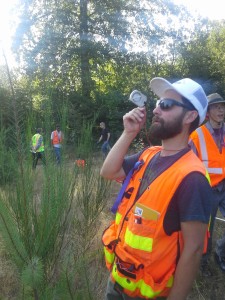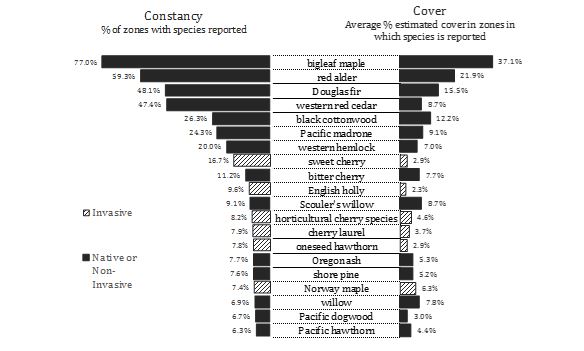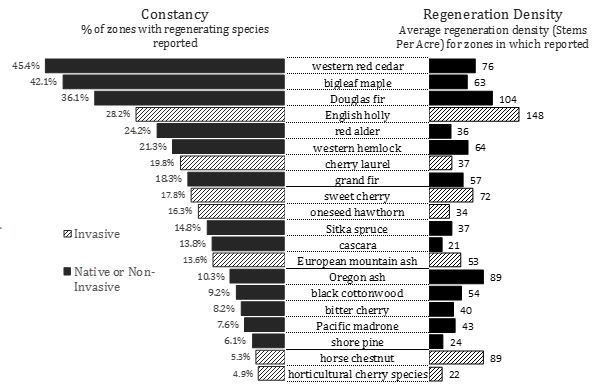Background
Green Seattle Partnership (GSP) annually inventories 300 – 500 acres of our active restoration sites using the GSP Inventory Protocols (available at www.greenseattle.org search: Inventory). Active restoration means that Parks staff, volunteers, or professional crews have initiated restoration activities such as invasive plant removal and planting. The Inventory allows us to monitor ecological change in these areas, while also updating the GSP online map. Data collected includes estimates of: understory and overstory cover, regenerating tree density and cover, and tree density. In 2015, 138 restoration zones were visited, covering 319 acres.
2015 Results
The following results include all data collected beginning in 2009 and through 2015, as displayed in the graph on the right. This adds up to 900 zones, covering 1,621 acres. The results presented below are a good snapshot of the zones where we see the most rapid change, and also provide us with some perspective on the progress citywide towards meeting our larger goal of restoring 2,500 acres of forested parkland. The Partnership is closing in on this goal within the next decade!
GSP splits up most forested parks where we do work into “zones,” which are distinct from each other due to size, ecological condition, topography, etc. In the graph below, one will see the twenty most common plant species shown down the middle listed in order of their abundance. This is called constancy, the frequency with which we find the particular plant during the inventory visit. On the right, one will see that when we find those particular species, the cover is the percentage of ground those plants occupy in the zones.
Most Common Species
You may notice that some trees are found often and provide a lot of canopy cover while other shrub and understory species are really common, but cover much less space in the zone. One will also see the comparison of native/non-invasive vs. non-native species. The intent of GSP restoration is to eradicate or control non-native plant species to give our natives a chance to thrive. While we still find plenty of non-natives in the parks, with investment of time and energy from the Partnership, we will see the invasive cover decrease over time to a level we can tolerate while the native plant communities expand with a little (or a lot) of stewardship from us.
Regenerating Trees
The phenomenon of plant communities “regenerating” on their own or with our stewardship is important for us to understand so we can develop methods to help urban forests sustain themselves with minimal assistance. Since protecting and expanding canopy cover has been a main driver of GSP, we observe and collect data on the presence of naturally occurring and planted trees in the active zones as part of the Inventory.
The figure below shows the frequency at which we find the most common regenerating trees species (constancy), and also the density, measured in trees-per-acre. When we first begin restoration in a park, we often find “woody invasive” tree species that were either planted or spread by seed in a park. The Partnership methodically removes holly, laurel, and other species that left unchecked, would dominate our forests. Our end goal is healthy native forests, but it takes more than removing the non-natives trees to see native trees spring up in their place. Poor soil conditions, persistence of invasive plants, lack of mature seeding native trees, and even shade from our native canopy, can make it difficult get longer-lived native conifers to regenerate on their own at our restoration sites.
While we do our best to make favorable conditions for a healthy forest, the Partnership relies on replanting, often 80,000 plants a year, to fill the space left after we remove the weeds. We plant at desirable densities (often shooting for 200-300 trees-per-acre), maintain, monitor, and replant in order to nurture our future forest. In the last decade, the Partnership has planted upwards of 190,000 native trees! There is strength in diversity, too, and we have over one dozen native tree species that we commonly install. We have 7 target forest systems we reference in planning and benchmarking our success. These targets generally lay out the road map for us to set the forested parklands on a healthy forest trajectory. Data and experience shows that our diligence in following the phases of restoration help us meet our goals.




Trackbacks/Pingbacks